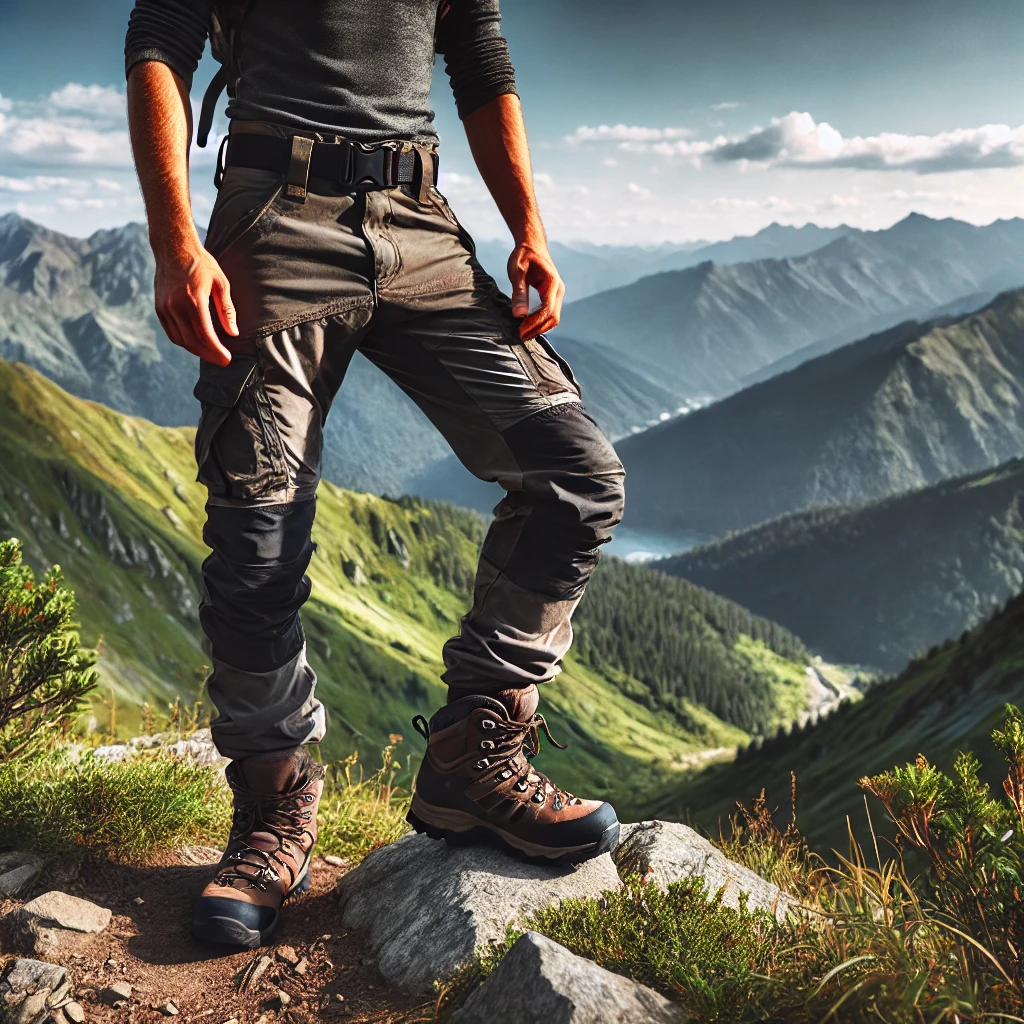
When it comes to hiking, having the right gear can make all the difference, especially when it comes to pants.
Whether you’re trekking through dense forests or scaling mountain peaks, comfort and durability are essential.
The best hiking pants should protect you from the elements, allow for easy movement, and withstand the toughest terrains.
With countless options available, we’ve done the hard work for you by compiling a list of the Top 10 Hiking Pants Men Swear By for Comfort and Durability.
These pants are built to last and offer the comfort you need on your adventures. Read on to discover which ones made the cut!
Criteria for Selecting the Best Hiking Pants:
Choosing the best hiking pants requires considering several factors that ensure your comfort, protection, and performance during outdoor activities.
Whether you’re embarking on a multi-day trek through the mountains or just taking a casual walk in the woods, having the right pair of pants can make a big difference.
Here are the key criteria to keep in mind when selecting hiking pants for men:
1. Durability
Durability is one of the most important aspects to consider when choosing hiking pants.
Your pants should be able to withstand tough environments, including rocks, brush, and rough terrain, without tearing or wearing out prematurely.
Look for materials like nylon and polyester, which are known for their high resistance to abrasion and tearing.
Reinforced areas, such as double-layered knees or seats, are also great for added protection and longevity.
- Pro Tip: If you plan to hike in areas with thorny bushes, rocks, or dense undergrowth, pants with extra reinforcement in high-stress areas are essential to prevent damage over time.
2. Comfort
Comfort is key when you’re hiking for hours or even days.
Pants made from stretchy fabrics like elastane blends allow for greater flexibility, which is crucial when you’re climbing, bending, or maneuvering over obstacles.
Additionally, the fit of the pants is important; hiking pants should be neither too tight nor too loose, allowing you to move freely without restriction.
- Key Features for Comfort:
- Elastic Waistbands: Offer flexibility and prevent discomfort during long hikes.
- Articulated Knees and Gusseted Crotches: These design features provide extra room and allow for a greater range of motion.
- Soft Lining: Some hiking pants feature a soft inner lining that enhances comfort, especially if you’re wearing them for long periods.
- Pro Tip: Convertible pants, which can be turned into shorts by zipping off the legs, offer a great blend of comfort and versatility for hikes where temperatures may change throughout the day.
3. Weather Resistance
When you’re out on a trail, you need hiking pants that can handle the elements.
Weather resistance is essential, especially if you’re hiking in unpredictable or harsh climates.
Many hiking pants come with water-resistant coatings that repel light rain or morning dew, keeping you dry in mild conditions.
For wet weather hikes, consider pants with a DWR (Durable Water Repellent) coating, which helps water bead off the surface.
- Key Weather Resistance Features:
- Quick-Drying Materials: Fabrics that dry quickly (usually nylon or polyester blends) are perfect for multi-day hikes where you may encounter streams, rain, or sweat.
- Wind Resistance: Pants with some wind-blocking properties can be invaluable when hiking at high altitudes or in cold climates.
- Breathability: While water resistance is important, you don’t want pants that trap heat and moisture inside. Look for breathable fabrics that keep you cool and dry from the inside out.
- Pro Tip: If you’re heading into areas with unpredictable weather, lightweight rain pants that pack down small can be a great addition to your gear.
4. Adjustability
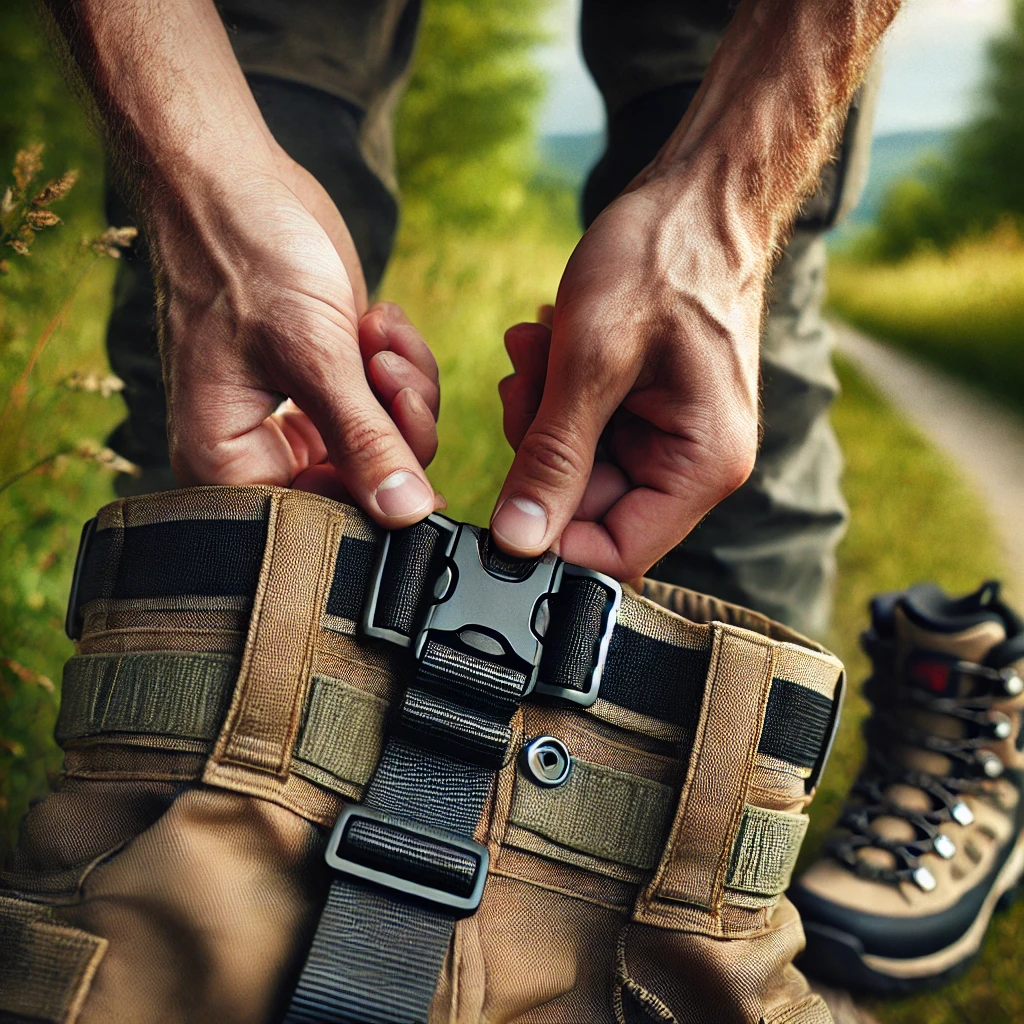
Good hiking pants should offer adjustability features that allow you to fine-tune the fit for your specific body shape and hiking needs.
This helps improve comfort during long treks and ensures your pants stay securely in place while you move.
- Adjustable Features to Look For:
- Waistbands: Elastic or adjustable waistbands, or even built-in belts, offer a customizable fit that prevents chafing and keeps the pants secure, even when carrying a heavy backpack.
- Cuffs: Some hiking pants come with adjustable cuffs that can be tightened to keep out debris, insects, or moisture, or loosened to fit over hiking boots.
- Zippers: Convertible pants with zippers at the knees allow you to turn full-length pants into shorts, making them perfect for hikes that transition from cool mornings to warm afternoons.
- Pro Tip: Velcro or cinch closures at the ankle allow you to adjust the fit over hiking boots, creating a more secure barrier against dirt, water, or bugs.
5. Pockets & Storage
Hiking requires access to small essential items like maps, snacks, or gadgets, which makes pocket placement and size important considerations.
Well-designed hiking pants will offer multiple, secure pockets that allow you to store items without them bouncing around or getting lost.
- Key Pocket Features:
- Zippered Pockets: Secure your valuables like keys, phones, or GPS devices.
- Deep Pockets: Ensure easy access to gear while also providing enough depth so items don’t easily fall out.
- Thigh Pockets: Often used for storing larger items like maps or snacks, these are easily accessible when you’re on the move.
- Pro Tip: Look for hiking pants with multiple pocket styles—zippered, cargo, and deep side pockets—to suit different types of gear. Some pants also feature hidden pockets for extra security when traveling.
6. Breathability
Maintaining a comfortable body temperature is crucial during physical activity, and breathable hiking pants can prevent overheating and excessive sweating.
Fabrics that wick moisture away from your skin allow you to stay dry even on intense hikes.
- Key Breathability Features:
- Ventilation Zippers: Some hiking pants come with zippers on the sides of the legs to enhance airflow when needed.
- Moisture-Wicking Materials: These fabrics draw sweat away from your skin, keeping you cool in hot conditions or during strenuous activity.
- Pro Tip: Lightweight, quick-drying pants are ideal for hot and humid climates. If you hike in cold conditions, look for pants that combine breathability with insulation, so you don’t trap sweat inside.
7. Weight
Weight is a key factor, especially for long hikes or backpacking trips.
Lighter pants are generally more comfortable for all-day wear, especially in hot climates, and they reduce the load you’re carrying on multi-day trips.
- Lightweight vs. Heavier Hiking Pants:
- Lightweight Pants: Typically made from thinner, breathable materials, these are great for warm weather or when you need to pack light. They are often quick-drying and fold up small, making them perfect for backpackers.
- Heavier Pants: Ideal for cold weather or rough terrain, these pants offer more protection and insulation. They might include thicker materials, reinforced areas, and windproof properties, but they could be bulkier to wear or carry.
- Pro Tip: If you’re preparing for a hike in a variable climate, consider lightweight pants that you can layer over thermal leggings when the temperature drops.
8. Style
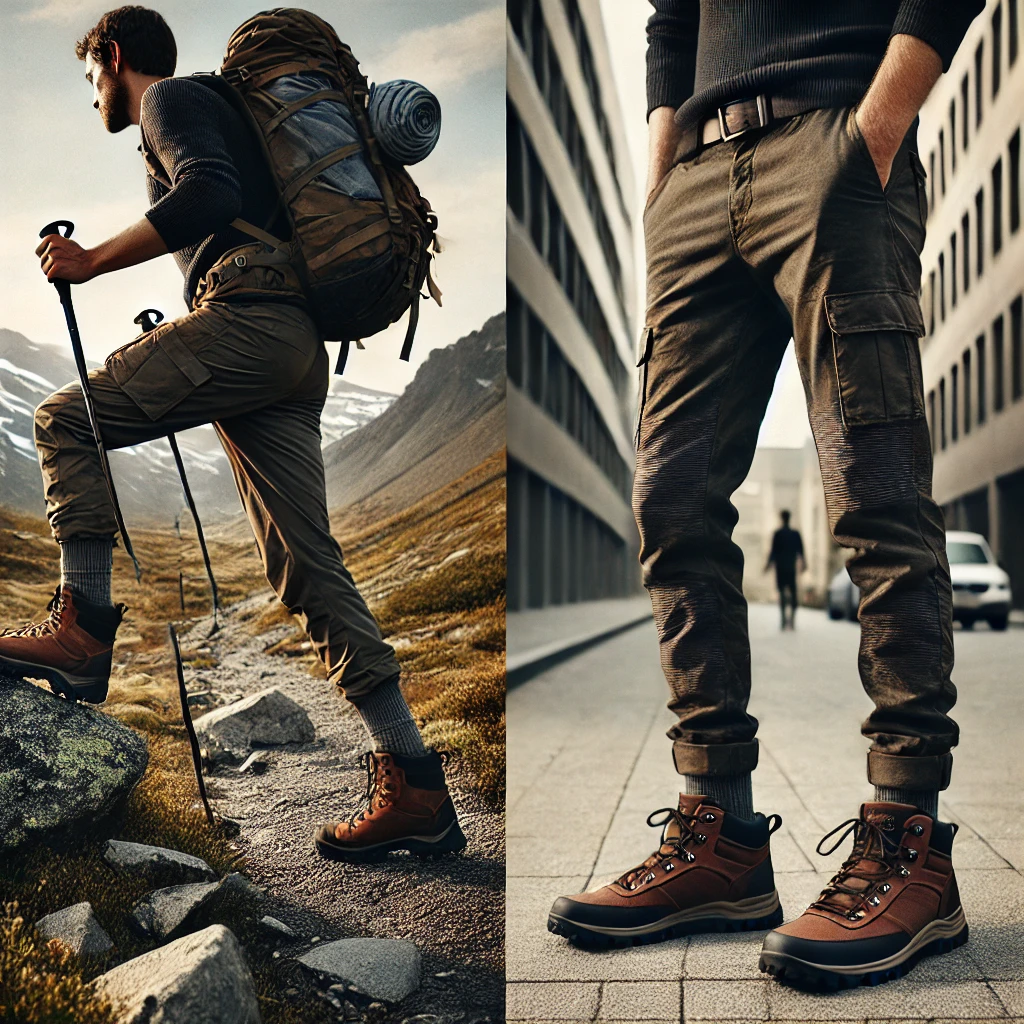
While functionality comes first, style is still a consideration.
Many hiking pants now come with a modern, streamlined design that looks just as good off the trail as on it.
From slim-fit designs to neutral color options, you can find hiking pants that work for both outdoor adventures and casual outings.
- Key Style Features:
- Convertible Pants: Great for those who want the option to turn their pants into shorts.
- Cargo or Streamlined Fit: Choose between a looser fit with cargo pockets or a more streamlined, slim fit depending on your personal style and hiking needs.
- Pro Tip: Choose pants in neutral colors (such as khaki, black, or gray) for versatility, as they can be worn in a range of outdoor or urban environments.
So…
When selecting hiking pants, focusing on factors such as durability, comfort, weather resistance, adjustability, and breathability will ensure you’re prepared for any adventure.
By considering these key criteria, you can confidently choose hiking pants that will keep you comfortable, protected, and ready to tackle whatever nature throws your way.
Top 10 Hiking Pants Men Swear By:
1. Columbia Men’s Silver Ridge Convertible Pant
- Description: Lightweight and breathable, these pants feature a convertible design, allowing you to zip off the legs and turn them into shorts when the temperature rises. They are built with moisture-wicking fabric to keep you dry and UV protection to guard against the sun.
- Pros:
- Convertible design for versatility
- Excellent moisture-wicking properties
- Built-in UPF 50 sun protection
- Cons:
- Zippers can be stiff
- Best For: Hikers tackling mixed terrain and variable weather conditions.
2. prAna Stretch Zion Pant II
- Description: Known for their durability and stretch, the prAna Stretch Zion pants are made from a water-repellent fabric that offers plenty of flexibility. They are ideal for long hikes where freedom of movement is crucial.
- Pros:
- Excellent stretch and mobility
- Durable water repellent finish
- Adjustable waistband for a custom fit
- Cons:
- Slim fit may not suit all body types
- Best For: Active hikers needing flexibility on technical trails.
3. The North Face Paramount Active Pant
- Description: Lightweight and breathable, these pants feature a water-repellent finish, articulated knees, and stretch material for maximum mobility. They are built to handle a variety of outdoor activities.
- Pros:
- Stretchy and flexible
- Water-repellent finish
- Secure zip pockets
- Cons:
- Less durable in extreme conditions
- Best For: All-day hikes in moderate climates.
4. Outdoor Research Ferrosi Pants
- Description: Lightweight and stretchy, these pants excel in offering comfort, breathability, and durability. They are wind- and water-resistant, making them great for high-energy hikes.
- Pros:
- Soft and comfortable fabric
- Wind and water-resistant
- Excellent breathability
- Cons:
- Not suitable for heavy rainfall
- Best For: Fast-paced hikes in windy or mildly wet conditions.
5. KUHL Renegade Rock Pants
- Description: These pants are designed with a softshell fabric that balances durability and comfort. The fabric is both stretchy and tough, providing plenty of range of motion while keeping you protected from the elements.
- Pros:
- Tough and durable
- Stretchy fabric for movement
- Water-resistant
- Cons:
- Heavier than some alternatives
- Best For: Rugged terrains and cooler climates.
6. Eddie Bauer Guide Pro Pants
- Description: A highly versatile option, the Eddie Bauer Guide Pro Pants are lightweight, flexible, and designed with a water-repellent finish. These pants come with two secure zip pockets and an adjustable waist for a perfect fit.
- Pros:
- Lightweight and comfortable
- Secure pockets for storage
- Durable water repellent finish
- Cons:
- Less durable in extremely rough environments
- Best For: Casual hikes and warm-weather adventures.
7. Arc’teryx Gamma LT Pants
- Description: These premium pants offer an impressive combination of durability and flexibility. Made with a durable, weather-resistant fabric, they provide all the comfort needed for extended hikes and multi-day treks.
- Pros:
- High durability and comfort
- Weather-resistant fabric
- Superior stretch
- Cons:
- Expensive
- Best For: Serious hikers and backpackers who need all-day comfort and protection.
8. Patagonia Quandary Pants
- Description: Lightweight and quick-drying, these pants are perfect for warm weather hiking. They are water-resistant, offer UPF 50+ sun protection, and have a slim yet comfortable fit.
- Pros:
- Lightweight and breathable
- Quick-drying and water-resistant
- Slim fit for modern styling
- Cons:
- Limited color options
- Best For: Warm-weather hikes and casual outdoor wear.
9. Fjallraven Vidda Pro Pants
- Description: Known for their ruggedness, the Fjallraven Vidda Pro Pants are built to withstand harsh conditions. They are made from G-1000 fabric, which is water-resistant and reinforced in key areas for extra durability.
- Pros:
- Extremely durable
- Reinforced knees and seat
- Adjustable leg openings
- Cons:
- Heavier than other hiking pants
- Best For: Hikers tackling rough terrain and extreme conditions.
10. Helikon-Tex Outdoor Tactical Pants
- Description: These tactical-style pants are highly durable and feature multiple pockets for practical use on long hikes. They are made from a ripstop fabric that is both water-resistant and breathable, perfect for tough outdoor activities.
- Pros:
- Highly durable ripstop fabric
- Plenty of storage pockets
- Water-resistant and breathable
- Cons:
- Bulkier design
- Best For: Hikers who need rugged durability and ample storage.
Buyer’s Guide: How to Choose the Best Hiking Pants for Men
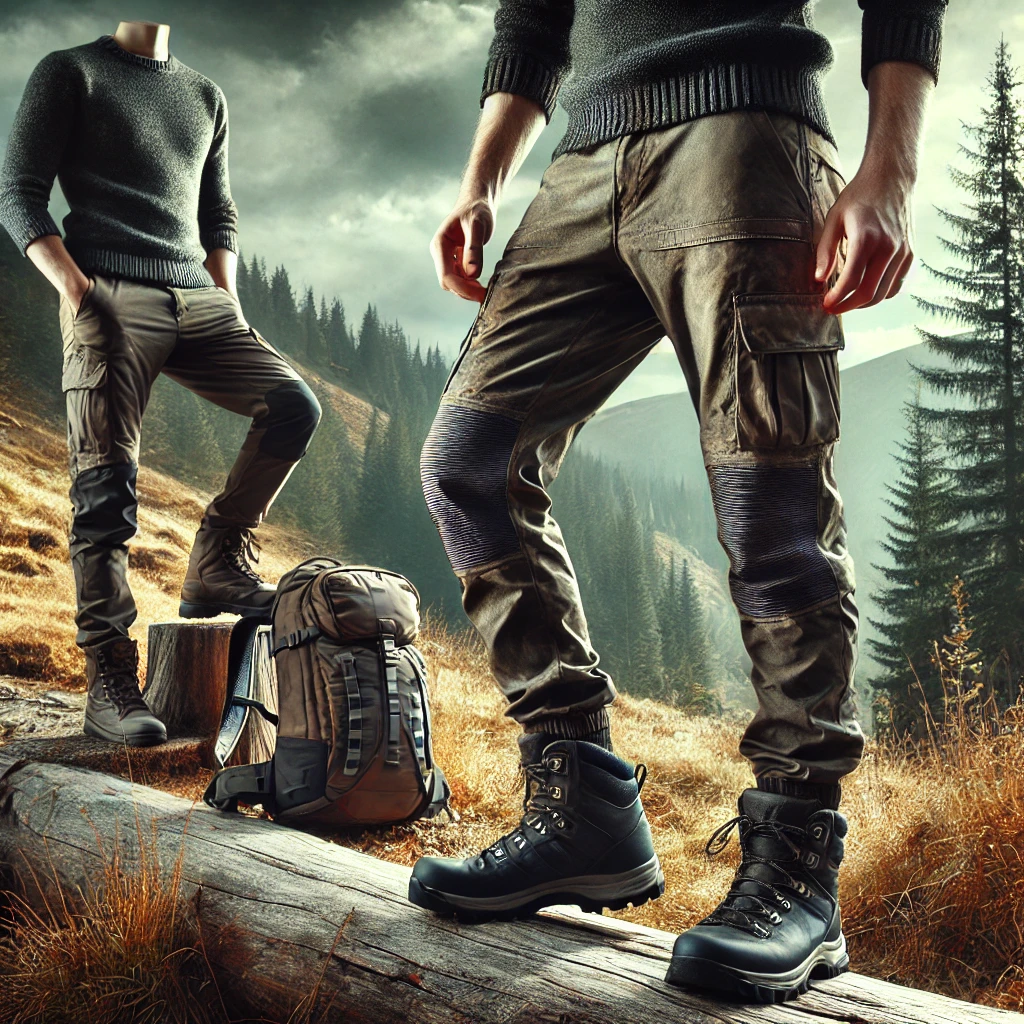
Selecting the right hiking pants can make a significant difference in your outdoor experience.
With the variety of styles, materials, and features available, it’s essential to consider your specific needs to find the best option.
Here’s a comprehensive guide on how to choose the best hiking pants for men, based on key factors like fit, fabric, weather resistance, and overall functionality.
1. Fit
The fit of hiking pants is critical for both comfort and performance on the trail.
A well-fitting pair of pants should allow you to move freely without restriction while still being snug enough to avoid excess fabric catching on branches or rocks.
- Regular Fit: Offers a balance between comfort and ease of movement, suitable for most hikers. These pants typically have a bit of room in the legs and seat, without being too tight or baggy.
- Slim Fit: Ideal for those who prefer a more streamlined look and want to reduce bulk. Slim-fit pants tend to be lighter and more form-fitting, but they may not provide as much range of motion for certain activities.
- Relaxed Fit: Designed for maximum freedom of movement, relaxed-fit hiking pants provide extra room in the legs, seat, and waist. They are often favored by hikers who carry heavy loads or traverse rugged terrain where flexibility is needed.
- Key Fit Features:
- Articulated Knees: Pre-shaped knees allow for greater freedom of movement when bending, kneeling, or climbing.
- Gusseted Crotch: An additional piece of fabric sewn in the crotch area to enhance range of motion and prevent chafing.
- Adjustable Waistbands: Elastic or adjustable waistbands with drawstrings or built-in belts ensure a secure, customizable fit.
- Pro Tip: When trying on hiking pants, simulate common movements like squatting, stepping up, or stretching to ensure the fit allows for full mobility without restriction or discomfort.
2. Material
The material used in hiking pants significantly impacts their performance, from durability and weight to moisture-wicking and breathability.
The most common materials used in hiking pants are nylon, polyester, and spandex/elastane blends.
- Nylon: Known for its durability, abrasion resistance, and quick-drying properties. Nylon is a top choice for rugged hikes where the pants are exposed to rough terrain.
- Polyester: Lightweight and moisture-wicking, polyester pants are great for warm-weather hikes. They may not be as durable as nylon but offer better UV resistance.
- Spandex/Elastane: Often blended with nylon or polyester, spandex adds stretch and flexibility to the pants, making them ideal for activities requiring a full range of motion.
- Pro Tip: Choose materials based on the terrain and weather conditions you’ll encounter. For instance, if you’re hiking in a rocky, brushy area, opt for pants with higher nylon content for better abrasion resistance.
3. Weather Resistance
Hiking pants need to protect you from the elements, whether it’s rain, wind, or extreme sun exposure.
Many hiking pants come with features that enhance their weather resistance, making them suitable for various outdoor conditions.
- Water Resistance: Hiking pants with a DWR (Durable Water Repellent) coating help repel light rain or moisture, keeping you dry during unexpected weather changes. However, they are not fully waterproof, so for heavy rain or wet environments, consider packing lightweight waterproof overpants.
- Wind Resistance: Wind-resistant hiking pants offer an extra layer of protection when hiking in high-altitude or exposed areas. This feature helps block cold air from penetrating, keeping you warm on windy days.
- UV Protection: If you’re hiking in sunny conditions, pants with built-in UPF (Ultraviolet Protection Factor) help shield your skin from harmful UV rays.
- Pro Tip: Check the label for weather-specific features like water repellency or UV protection to ensure your pants match the hiking conditions you’ll face.
4. Breathability
Breathability is crucial for comfort, especially on long hikes or in hot weather.
Your pants need to allow airflow to keep you cool and wick away moisture to prevent sweat from building up and causing discomfort.
- Quick-Drying Fabrics: Fabrics like nylon and polyester dry quickly, making them ideal for humid environments or multi-day hikes where you may encounter streams or rain.
- Ventilation Zips: Some hiking pants feature zippers on the thighs or lower legs, allowing you to increase airflow during high-intensity hikes or hot weather.
- Pro Tip: Opt for pants with moisture-wicking properties if you sweat a lot or plan to hike in warm, humid conditions. These fabrics will help keep you dry and reduce chafing.
5. Convertible or Non-Convertible
Convertible pants offer versatility by allowing you to zip off the lower legs, turning full-length pants into shorts.
They are perfect for hikes that start in cool weather and warm up later in the day.
- Convertible Pants: These pants offer the benefit of both shorts and full-length pants in one package. They are ideal for hikers who want to minimize packing but be prepared for changing weather.
- Non-Convertible Pants: If you don’t like the zippers or the added bulk of convertible pants, regular full-length hiking pants may offer a more streamlined fit.
- Pro Tip: Convertible pants are a great option for longer hikes or backpacking trips where you expect temperature fluctuations. They’re also useful for hiking in regions where cold mornings turn into hot afternoons.
6. Pockets and Storage
When you’re on a hike, having easy access to essential items like maps, snacks, or tools is crucial.
The design and placement of pockets can greatly affect convenience and comfort.
- Zippered Pockets: For items like your phone or GPS, secure zippered pockets are a must to ensure they don’t fall out while hiking.
- Thigh or Cargo Pockets: These provide additional storage for larger items like maps, snacks, or even a small camera.
- Back Pockets: Some hiking pants come with back pockets that offer extra storage, but be mindful that too much gear in these pockets can cause discomfort, especially when wearing a backpack.
- Pro Tip: Look for pants with a combination of deep side pockets and secure zippered pockets to store valuables and easy-access items separately.
7. Weight
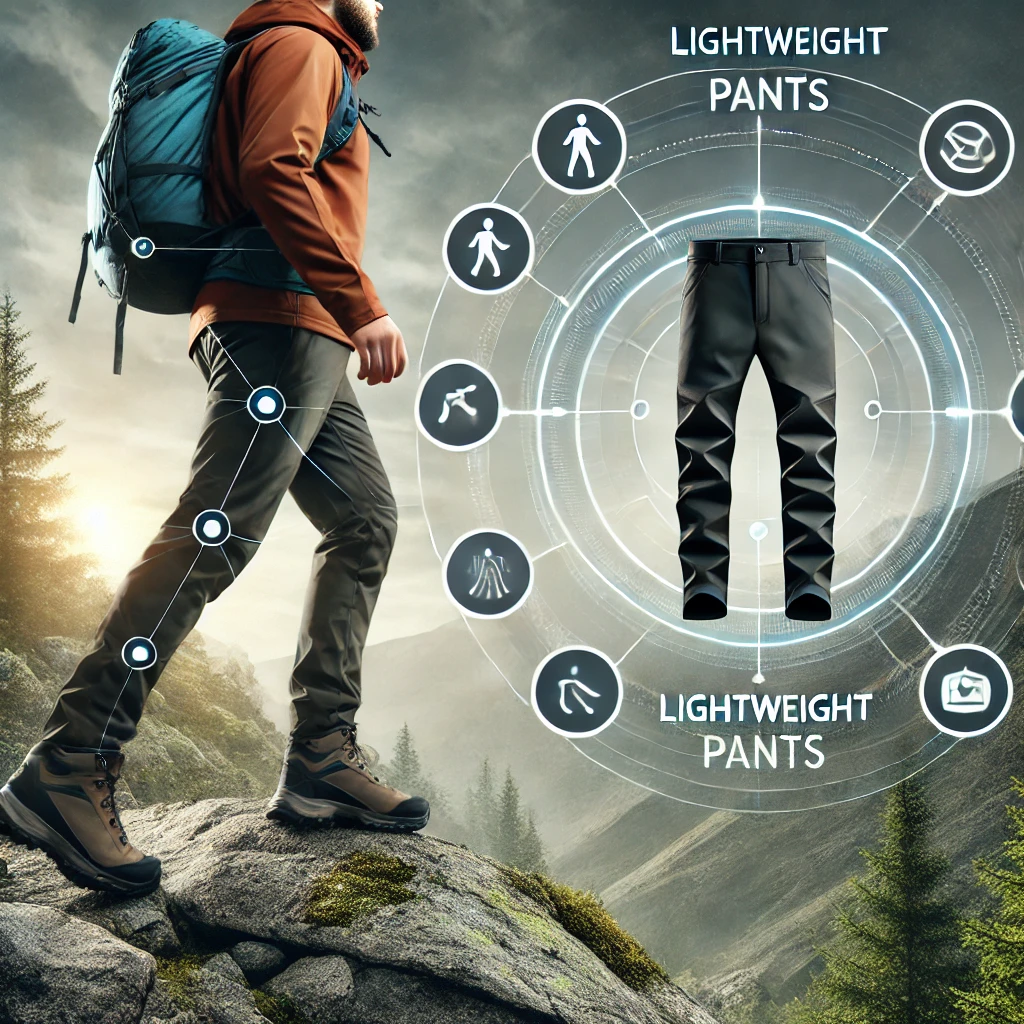
The weight of your hiking pants can impact your overall comfort, especially on longer hikes.
Lighter pants are generally more breathable and comfortable in warm weather, while heavier pants offer more durability and protection in rugged terrain or colder climates.
- Lightweight Pants: Typically made from thin, breathable fabrics, lightweight hiking pants are ideal for hot-weather hikes or fast-paced activities. They also pack down easily, making them great for multi-day trips or backpacking.
- Heavyweight Pants: These are better suited for colder climates or rough terrain, as they often offer more protection and insulation. However, they can feel bulky and may not dry as quickly as lighter fabrics.
- Pro Tip: Choose lightweight pants for summer or warm-weather hikes and heavier pants for winter or rugged environments. If you anticipate a variety of conditions, consider packing a lightweight pair of pants with an optional rain or wind shell.
8. Durability
Durability is critical, especially if you’re hiking in rough or rugged environments.
Pants that tear or wear out easily won’t last long on the trail, so it’s essential to invest in a durable pair made from strong materials.
- Reinforced Knees and Seat: Look for hiking pants with double-layered fabric in high-wear areas like the knees and seat. This added durability can prevent tearing and prolong the lifespan of your pants.
- Abrasion-Resistant Materials: Nylon is one of the most durable fabrics for hiking pants, offering excellent resistance to wear and tear from rocks, branches, and other trail obstacles.
- Pro Tip: For rough terrain or bushwhacking, choose pants with reinforced panels or abrasion-resistant materials to ensure they can withstand the challenges of the trail.
9. Style and Versatility
While functionality should always come first, style and versatility are also worth considering, especially if you want pants that can transition from trail to town.
Many hiking pants now come in modern, sleek designs that look good in casual settings as well as on the trail.
- Convertible Designs: Convertible hiking pants offer versatility and can double as both pants and shorts, making them ideal for travel or multi-day hiking trips.
- Neutral Colors: Opt for neutral colors like khaki, black, or olive, which blend in well with different environments and look good in both outdoor and urban settings.
- Pro Tip: If you want hiking pants that are suitable for both outdoor activities and everyday wear, choose a slim-fit or modern design in neutral tones that pair easily with other wardrobe items.
Conclusion
When choosing hiking pants, it’s important to consider your specific needs and the environment you’ll be hiking in.
Focus on finding a pair that offers a combination of durability, comfort, weather resistance, and breathability.
Whether you need lightweight pants for warm climates or rugged, insulated pants for extreme conditions, the right hiking pants can enhance your outdoor experience and keep you comfortable and protected on the trail.
By keeping these factors in mind, you can confidently select the best hiking pants for your adventures.
FAQ Section:
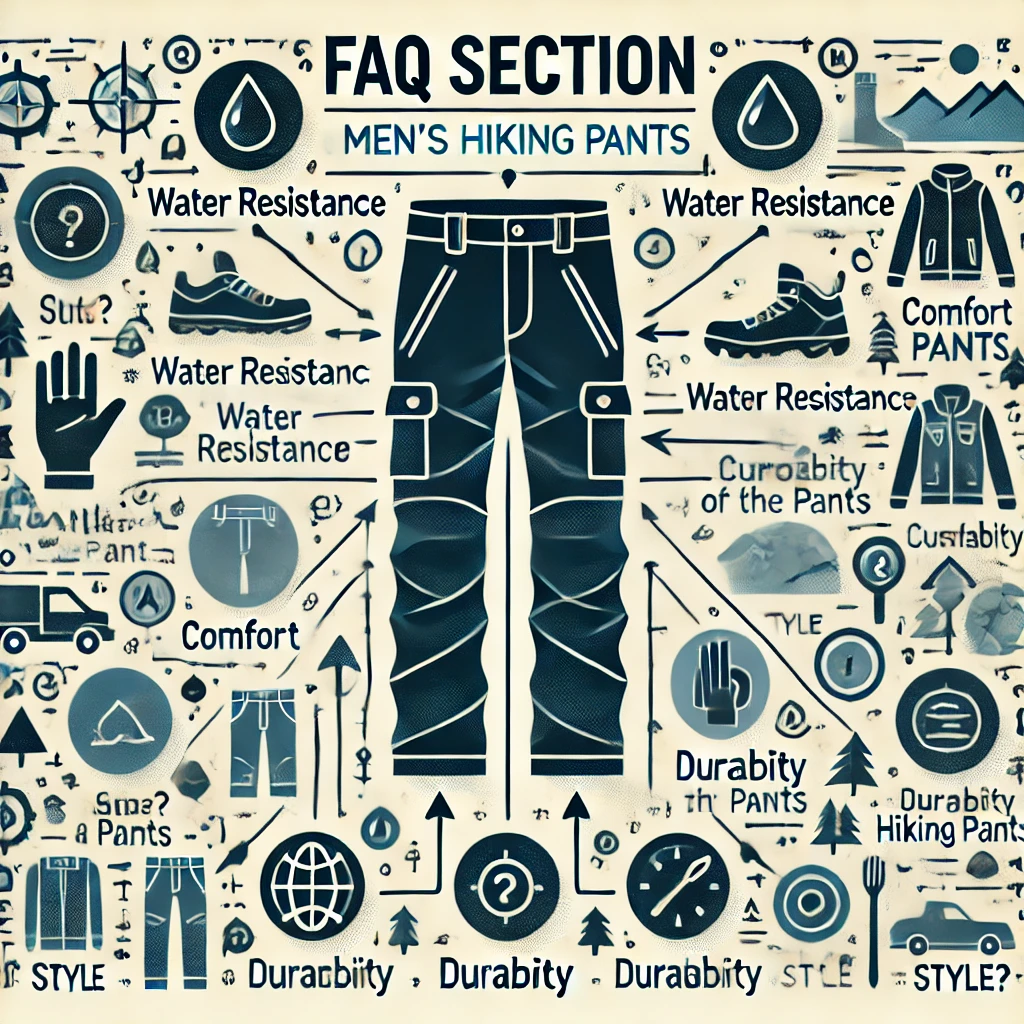
Q: Can I wear hiking pants in all seasons?
Yes! Many hiking pants are designed to be versatile and suitable for various weather conditions.
Convertible options or lightweight pants work well for summer, while water-resistant, insulated pants are ideal for colder months.
Q: Are hiking pants worth the investment?
Absolutely.
The right hiking pants offer comfort, durability, and protection, ensuring you can enjoy your outdoor adventure without discomfort or gear failure.
Q: What’s the difference between hiking pants and regular outdoor pants?
Hiking pants are typically more durable, lightweight, and designed with specific features like stretch, breathability, and water resistance to handle tough outdoor conditions better than regular pants.
Choosing the best hiking pants is crucial to ensure a comfortable and enjoyable outdoor adventure.
With options for every type of hiker, from casual trekkers to rugged mountaineers, this list has something for everyone.
Don’t forget to consider your specific needs, like weather protection, storage, and fit, before making your choice.
Happy hiking!
Bonus Tip: Be sure to check out the reviews for these pants and consider trying them on for the perfect fit.
Investing in the right pair will pay off on your next adventure!
Related Articles:
Hiking Boots for Men: Top 10 Picks for Every Trail Adventure
Top 10 Hiking Sneakers: An In-Depth Rating and Review
As an Amazon Associate I earn from qualifying purchases.

